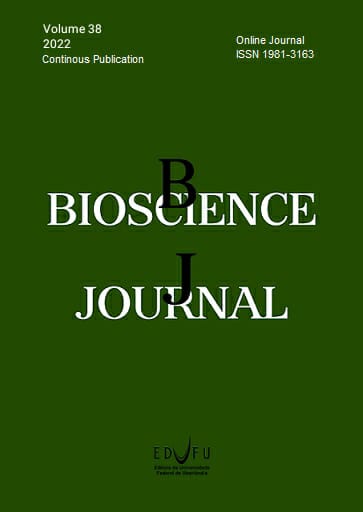Seed size and presence of thorns in Caryocar brasiliense on seedling emergence
DOI:
https://doi.org/10.14393/BJ-v38n0a2022-55572Keywords:
Emergence speed index., Germination, Seed Classification, Seed Dormancy.Abstract
Commercial propagation of pequizeiro, which stands out among the main native fruits of the Cerrado region for its high economic potential, has been done by seeds, despite their erratic germination. The objective of this study was to evaluate the effect of seed size and presence of thorns on the endocarp on seedling emergence of pequizeiro in the field. Seeds were collected in a pequizeiro commercial area in Canarana-MT, Brazil. Due to availability, 2,353 thorny seeds (3 sizes) and 106 seeds without thorns (medium sized) were tested. Thorny seeds were classified as large – longer than 50 mm; medium – between 40 and 50 mm; small – less than 40 mm. Seedling emergence started after 50 days in all seed categories, extending up to 100 days in the large seeds and to about 1 year after sowing in the small and medium sized ones. Small seeds showed a lower rate and speed of emergence compared to the others. Large seeds showed higher emergence speed compared to the medium ones. The presence of thorns did not affect seedling emergence. These results indicate the advantages of pequizeiro seed classification for sowing purposes.
References
CARVALHO, C.G.S., et al. Efeito de diferentes tratamentos na germinação do pequi (Caryocar brasiliense Camb.). Acta Botânica Brasilica. 1994, 8(1), 109-120. https://doi.org/10.1590/S0102-33061994000100011
CARVALHO, N.M. and NAKAGAWA, J. Sementes: ciência tecnologia e produção. 5th ed. Jaboticabal: Funep, 2012.
GERITZ, S., GYLLENBERG, M. and TOIVONEN, J. Adaptive correlations between seed size and germination time. Jornal of mathematical biology. 2018, 77, 1943-1968. https://doi.org/10.1007/s00285-018-1232-z
LEÃO, E.F., PEIXOTO, N. and MORAIS JÚNIOR, O.P. Emergência de plântulas de pequizeiro em função da planta matriz e uso de ácido giberélico. Pesquisa Agropecuária Tropical. 2012, 42(4), 416-423. https://doi.org/10.1590/S1983-40632012000400009
LIMA, A., et al. Composição química e compostos bioativos presentes na polpa e na amêndoa do pequi (Caryocar brasiliense, Camb.). Revista Brasileira de Fruticultura. 2007, 29(3), 155-159. http://dx.doi.org/10.1590/S0100-29452007000300052
MARANHO, A., PAIVA, A.B. and PRADO DE PAULA, S.R. Initial growth of native species with timber potential in Amazon, Brazil. Revista Árvore. 2013, 37(5), 913-921. https://doi.org/10.1590/S0100-67622013000500014
MELO, J.T. and GONÇALVES, A. N. Inibidores de germinação em frutos e sementes de pequi. 1st ed. Brasília: Embrapa Cerrados, 2001. Available from: http://ainfo.cnptia.embrapa.br/digital/bitstream/CPAC-2010/23731/1/bolpd-23.pdf
MENDES, D.S.T. Germinação e armazenabilidade de sementes de pequizeiro. Montes Claros: Universidade Federal de Minas Gerais, 2015. Available from: http://hdl.handle.net/1843/NCAP-9Y7G4L
NIETSCHE, S., et al. Tamanho da semente e substratos na germinação e crescimento inicial de mudas de cagaiteira. Ciência e Agrotecnologia. 2004, 28(6), 1321-1325.
OLIVEIRA, M.C., et al. Pequi peel flour in diets for Japanese quail. Acta Scientiarum. Animal Sciences. 2016, 38(1), 101-106. https://doi.org/10.4025/actascianimsci.v38i1.28381
PEREIRA, S.R., et al. Tamanho de frutos e de sementes e sua influência na germinação de jatobá-do-cerrado (Hymenaea stigonocarpa var.stigonocarpa Mart. ex Hayne, Leguminosae – Caesalpinoideae). Revista Brasileira de Sementes. 2011, 33(1), 141-148. https://doi.org/10.1590/S0101-31222011000100016
RIBEIRO, H.B., et al. Resíduos de frutos de pequi no controle do nematoide das galhas em tomateiro. Horticultura Brasileira. 2012, 30(3), 453-458. http://dx.doi.org/10.1590/S0102-05362012000300016
ROCHA, J.P. Fatores genéticos e ambientais na emergência de plântulas de pequizeiro (Caryocar brasiliense camb.). Diamantina: Faculdade de Ciências Agrárias, Universidade Federal dos Vales do Jequitinhonha e Mucuri, 2009. Tese de doutorado.
ROCHA, L.B., et al. Gallic acid as the major antioxidant in pequi (Caryocar brasiliense Camb.) fruit peel. Revista Brasileira de Plantas Medicinais. 2015, 17(4), 592-598. https://doi.org/10.1590/1983-084X/14_062
SANTOS, F.S., et al. A cultura do Pequi (Caryocar brasiliense Camb.). Acta Iguazu. 2013, 2(3), 46-57.
SILVA, K.S., et al. Influência do tamanho da semente na germinação e vigor de mudas de jaqueira (Artocarpus heterophyllus Lam.). Revista Verde. 2010, 5(4), 217 – 221.
SILVA, E.C. and LEONEL, L.V. Avaliação da germinação de sementes de pequizeiro (Caryocar brasiliense Camb) submetidas a diferentes concentrações de ácido giberélico. Cultura Agronômica. 2017, 26(2), 217-223.
WAGNER JÚNIOR, A., et al. Germinação e desenvolvimento inicial de duas espécies de jabuticabeira em função do tamanho de sementes. Acta Scientiarum Agronomy. 2011, 33(1), 105-109. https://doi.org/10.4025/actasciagron.v33i1.4881
Downloads
Published
Issue
Section
License
Copyright (c) 2022 Ricardo Carmona, Daniel Franklin Nunes Ferreira, Thiago Estácio da Costa, Luís Carlos Carvalho Júnior, Antônio Alves de Oliveira Júnior

This work is licensed under a Creative Commons Attribution 4.0 International License.





